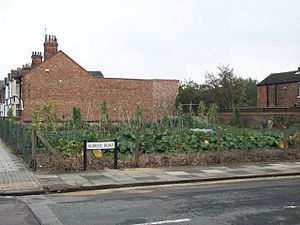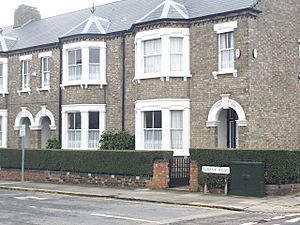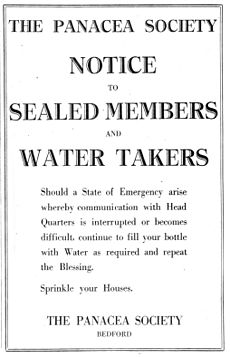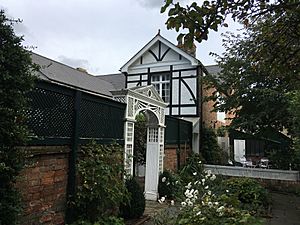Panacea Society facts for kids
The Panacea Society was a religious group that started in Bedford, England, in 1919. They followed the ideas of a prophetess named Joanna Southcott, who had died a long time before, in 1814. A main goal of the Society was to get a special sealed box of Southcott's prophecies opened. The group also believed that Bedford was the true location of the Garden of Eden.
Contents
The Panacea Society's Story
The Panacea Society was inspired by the teachings of Joanna Southcott (1750–1814). It was founded in 1919 by Mabel Barltrop in Bedford. Mabel Barltrop was a widow. She called herself the 'daughter of God' and took the name Octavia. She believed she was a special figure mentioned in Southcott's prophecies.
Mabel Barltrop and 12 other people started the Society. They first called it the Community of the Holy Ghost.
The Sealed Box Campaign
A main aim of the Society was to convince 24 Anglican bishops to open Southcott's sealed box of prophecies. They put advertisements in many newspapers to achieve this. In the late 1920s and early 1930s, the Society gathered over 100,000 requests to open the box.
The Society claimed they had the real box. They believed that a box opened in 1927 was not the correct one. That box had only contained an old pistol and a lottery ticket.
Healing Practices
Another important activity of the Panacea Society was offering healing. They claimed to heal all diseases, including cancer. People would write to their headquarters in Bedford. They would then receive a piece of linen blessed by Octavia.
People were told to put the linen in water, pray, and drink this "Water A" four times a day. This water could then be mixed with more water to make "Water B." "Water B" was used for bathing or applying to the body. From 1924 to 2012, about 130,000 people received these linen pieces for free. They were only asked to write back about their results. The letters from people all over the world are kept at the Panacea Museum in Bedford.

Society Locations
The Society had its main offices on Albany Road in Bedford. This was near the old Bedford Castle. They also had a house called The Ark on Albany Road. This house was kept ready for the Messiah, who they believed would return one day.
Even though the Society was small, it was quite wealthy. They owned several properties in the Castle Road area of Bedford. By 2001, the Society began selling some of its properties. This was to keep its status as a charity. At that time, they had assets worth about £14 million.
Who Were the Members?
In the 1930s, around 70 members lived in the Bedford community. By 1967, about 30 members were living there. The last member, Ruth Klein, passed away in 2012. After her death, the Panacea Society stopped being a religious community.
The Panacea Charitable Trust
The religious group no longer exists, but a charity still does. This charity is now called The Panacea Charitable Trust. It helps fund research into religious movements that believe in future prophecies. It also gives money to other charities and groups in Bedford. These groups work to help people with poverty and health issues.
The Panacea Museum
In late 2012, the charitable trust announced they would open a museum. The Panacea Museum is located at 9 Newnham Road, Bedford. It is in a Victorian house called 'Castleside'. This house was part of the community's main headquarters. The museum tells the story of the Panacea Society and other similar religious groups.
The museum also includes other buildings within the gardens. These buildings were part of the original community's area. The museum is open every Thursday, Friday, Saturday, and Sunday. It opens from February half term until the end of October.




